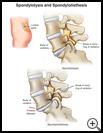
Spondylolysis and Spondylolisthesis
________________________________________________________________________
KEY POINTS
- Spondylolysis and spondylolisthesis are problems in the lower part of your spine. Spondylolysis is a break in one or both sides of the bony ring through which the spinal cord and nerves travel. Spondylolisthesis means that a bone in your lower back has slipped out of place because of a break in the ring.
- Treatment may include stretching and strengthening exercises, a brace, or surgery.
- Keeping your muscles strong, not bending backward too far, and doing warm-up and stretching before activities can help prevent problems.
________________________________________________________________________
What are spondylolysis and spondylolisthesis?
Spondylolysis and spondylolisthesis are problems in the lower part of your spine. Your lower spine is made up of 5 bones called the lumbar vertebrae. Each bone has 2 main parts: a solid part called the body, and a bony ring through which the spinal cord and nerves travel. Between the bodies of the bones are rubbery, shock-absorbing disks.
Spondylolysis is a break in one or both sides of the ring of a vertebra. If the body of one of the vertebrae has slipped out of place because of a break in the ring, it is called spondylolisthesis.
What is the cause?
Breaks in the rings of the vertebrae are caused by stress on these bones. These stress fractures usually result from activities that involve a lot of bending forward and backward. The rings of the lower backbones get weaker and can break. Sometimes an injury to the back is the cause. Gymnasts, dancers, weight lifters, and football players are most often diagnosed with these conditions.
You have a higher risk for this type of fracture if you were born with weak bones.
What are the symptoms?
You may have no symptoms at all or you may have low back pain or spasms. A spasm is a sudden tightening of the muscles that you cannot control. You may have pain all of the time or only from time to time.
How is it diagnosed?
Your healthcare provider will ask about your symptoms, activities, and medical history and examine you. You may have:
- X-rays
- CT scan, which uses X-rays and a computer to show detailed pictures of the spinal cord and the tissues around it
- MRI, which uses a strong magnetic field and radio waves to show detailed pictures of the spinal cord and tissues around it
How is it treated?
If the fracture is new and your healthcare provider thinks that the bones can heal without surgery, you may need to wear a brace for 1 to 3 months. Severe cases of spondylolisthesis may require surgery.
Your healthcare provider may recommend stretching and exercises or physical therapy to help you heal.
How can I take care of myself?
To help relieve swelling and pain:
- Put an ice pack, gel pack, or package of frozen vegetables wrapped in a cloth on your lower back every 3 to 4 hours for up to 20 minutes at a time.
- Take nonprescription pain medicine, such as acetaminophen, ibuprofen, or naproxen. Read the label and take as directed. Unless recommended by your healthcare provider, you should not take these medicines for more than 10 days.
- Nonsteroidal anti-inflammatory medicines (NSAIDs), such as ibuprofen, naproxen, and aspirin, may cause stomach bleeding and other problems. These risks increase with age.
- Acetaminophen may cause liver damage or other problems. Unless recommended by your provider, don't take more than 3000 milligrams (mg) in 24 hours. To make sure you don’t take too much, check other medicines you take to see if they also contain acetaminophen. Ask your provider if you need to avoid drinking alcohol while taking this medicine.
Follow your healthcare provider's instructions, including any exercises recommended by your provider. Ask your provider:
- How and when you will get your test results
- How long it will take to recover
- If there are activities you should avoid and when you can return to your normal activities
- How to take care of yourself at home
- What symptoms or problems you should watch for and what to do if you have them
Make sure you know when you should come back for a checkup.
How can I help prevent these conditions?
Here are some of the things you can do to help prevent back problems:
- Do warm-up exercises and stretching before activities to help prevent injuries.
- Do exercises that strengthen your back and belly muscles.
- Avoid activities that force the back to extend, such as tackling in football.
- Keep a healthy weight. Lose weight if you are overweight.
- Follow safety rules and use any protective equipment recommended for your work or sport.

